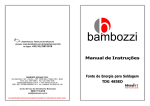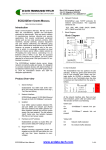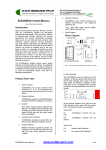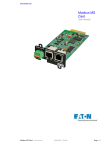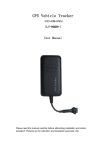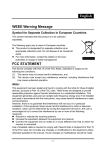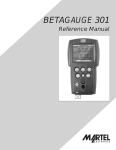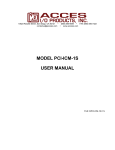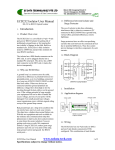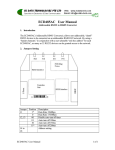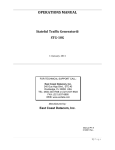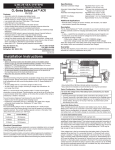Download View User Manual ()
Transcript
Offers the option of 9-pin d-sub shell con- ECD485IC USERS MANUAL nector (AT style) or large capacity (2.5mm²) ISOLATED RS-232 TO RS-485 CONVERTER compression screw terminals, giving maxi- FOR 2 AND 4-WIRE RS-485 WITH GROUND WIRE mum flexibility in installation in panels and 1. INTRODUCTION terminal boxes. RS-485 has become one of the most common 9-pin female “DCE like” ports allow use of data communication standards in "open" multi- ribbon cables from 9-pin computer ports. vendor automation projects. More robust than 600 watt transient suppresser diodes are RS-232 and more flexible than RS-422, it allows a installed on isolated ports single master device to communicate with mul- (600w for 1ms with less than 1psec response to over- tiple slave devices. voltage) 1.1. Product Over-view For robust operation, the ECD485ic is an essen- 1.2. What is RS232? +V tial component of your industrial applications. RS-232 is an inter- --V It provides the following unique combination of face standard - features: not a 0V data 01010011 ASCII "I" Safely converts between EIA standard RS- communication 232 and RS-485 signals. standard. This means it can only go short dis- Isolates and protects the data signals and power supply grounds. tances and has very limited driving power. It provides full-duplex, point-to-point data transfer between two devices. The signal ground is in- With floating grounds, RS-232 cable runs up cluded as one of the wires, so it is very to 50m can be guaranteed with quality, susceptible to damaging ground loops. Data is low-capacitance cable like Beldon 1422A transmitted as a voltage polarity relative to the at 42pF/m. (RS-232 requires < 2500pF per common signal ground. For example, here is signal wire.) the signal for an ASCII character 'I'. When sig- Over 2500v optical isolation between RS232 and RS-485 (5kv test isolation) and 2500v galvanic isolation between RS-485 and the power supply (3kv test isolation). The full isolation 3-port model also has isolation between RS-232 and power supply. nal voltage > +3v, then the data is a binary 0. When signal voltage < -3v, then the data is a binary 1. A voltage signal between -3v and +3v is undefined. An idle line without data will be in the binary 1 state. This voltage signal referenced to a shared ground is quite susceptible to noise, plus the existence of the For rapid troubleshooting, LED indicators for the TX, RX, and power status. ground wire leads to grounding and surge problems. Wide power supply range (9 to 36vdc) with spike protection allows use with 9v, 12v, 15v, 24v power supplies or direct from 12v or 24v battery systems. ECD485ic User Manual www.ecdata-tech.com 1 of 6 1.3. What is RS-485? RS-485 is a half-duplex data communication 2. FUNCTIONAL DESCRIPTION A standard which can be use for point-to-point or multi-drop applications. B It uses twisted wire pairs. Data is transmitted by a differential volt- 01010011 ASCII "I" age signal. The two wires in a pair are not a loop -- both are '+' signals sourcing current to a third "virtual" ground conductor. For example, here is the differential signal for an ASCII character 'I'. Though labels vary from vendor to vendor, one wire of the pair is often labeled A and the other B. Data is represented by the relative voltage of A to B. When VA < VB, then the data is a binary 1. When VA > VB, then the data is a binary 0. An idle line without data will be in the binary 1 state. This differential voltage signal is quite robust and not susceptible to noise or minor shifts in signal reference ground. 1.4. Two or Four Wire RS-485 One wire pair is used as a bi-directional bus, first transmita "request" "response". and A power conditioning circuit steps 9-36vdc down to a stable, filtered 5vdc. High isolation DC-to-DC converters convert this to one or two isolated 5vDC supplies. In all models (-2p and 3p), RS-485 port-A has a fully isolated supply. In the case of full 3-of-3 port galvanic isolation models (option -3p), RS-232 port-B also has an isolated supply, while in the partial 2-of-3 port galvanic isolation models (option -2p), RS-232 2-wire RS-485 is strictly half-duplex. ting 2.1. Isolated Power Supply then receiving a Many industrial products support both 2 or 4 wire RS-485. Providing terminals for 4-wire, they allow external jumpers to short the two A signals and two B signals for 2-wire. port-B is powered directly from the filtered 5vdc without isolation. 2.2. Optical Isolation for Data Signals Digital opto-couplers are used to move the data signals between the two sides of the converter. These are superior to the more common analog opto-couplers, as they add little distor- 4-wire uses two twisted wire pairs - one for tion and therefore support high baud rates. transmit and one for receive. The Tx pair is used The isolated power supplies and optical data by a master device to communicate with the signals complete the galvanic isolation re- slave devices, and the Rx pair is used by the quired. slave devices to respond. 4-wire RS-485 is more robust than 2-wire with low quality cable or high environmental noise. It also reduces the data communication interrupt load on the slave devices. 2.3. RS-485 Bus Transceiver Line interface driver/receiver chips convert the field signals to standard TTL-level signals. The full EIA/RS-485 specification is meet by using SN75176 compatible chips. Since 2-wire RS-485 Note that there is a special form of 2-wire is a bi-directional bus, it requires the transmit- RS-485 which allows an optional 2nd wire pair ter/receiver circuit to switch between transmit to be used as a control (RTS) signal to manage and receive as appropriate - the ECD485ic uses repeaters in the system. ECD485ic User Manual www.ecdata-tech.com 2 of 6 an effective method to do this with 100% soft- Unfortunately, there are two common logic ware transparency. systems. Computer systems treat 0v and 5v as 0 and 1 respectively, while the most common 2.4. User Indication RS-485 chips label (and general telecommunications) treat 0v and 5v as 1 and 0 respectively. To avoid the issue, many vendors select other naming conventions. 3.2. Determining terminal names The face of the ECD485ic is shown above. Green LEDs (Pwr-A & Pwr-B) light showing isolated power is available from the isolated DCto-DC converters. Yellow LEDs (Rcv-A, Txd-A & Rcv-B, Txd-B) light when data is received and transmitted on the respective port (RS-485 is port A, RS-232 is port B). EC Data names it's A/B terminals as “-“ and “+” respectively - since when measured by a volt meter, the “A” terminal of an idle asynchronous RS-485 data line will be a lower voltage than the “B” terminal. Another common naming conventions is to label them as "X"/"not X", where X is a name like DAT or BUS, and the "not" 2.5. Signal Conditioning condition is marked either by a bar over the For normal operation, the ECD485ic has 6 name or a leading "*". An example would be jumpers installed to terminate and bias the RS- "DAT+/DAT-" or "DAT/*DAT". 485 interface. These are only removed when and "not" terminals correspond to "A", but ven- more than two (2) units of ECD485ic are con- dors are free to label them opposite here as nected to the same RS-485 wire pair. well. For example, if 4 units of ECD485ic connect to a wire pair, at least 2 of them must have all 3 jumpers removed. Both ports have transient suppression diodes rated at 500w or higher. 3. DETERMINING RS-485 TERMINAL NAMES Due to a lack of naming conventions, wiring multi-vendor RS-485 devices often involves wiring "apples" to "oranges". It may require some bench-top experimentation. While this sounds bad, it is often required when integrating multivendor systems. Neither the RS-485 nor the RS232 interface can be damaged by reverse wir- Generally the "--" A direct method to determine the absolute A/B terminals would be helpful. If your asynchronous device outputs a voltage when idle, then the terminal with the higher voltage is "+". Unfortunately, most devices will show no measurable voltage difference between their terminals; slave devices are normally in receive mode and do not affect the terminal voltage. 4. INSTALLATION 4.1. Making Standard RS-232 Cables The ECD485ic has one 9-pin female connector which looks like a 9-pin “modem” or DCE port. ing or short-circuits to ground. cable w 9-pin m 3.1. Per EIA-485 Txd Rxd EIA-485 defines the labels "A" and "B" to be Gnd rdc485ic used as follows: Voltage of A shall be negative in respect to B for a binary 1. Sounds simple? Cable A : host with 9-pin DTE port ECD485ic User Manual www.ecdata-tech.com 3 of 6 RS-485 2-wire Cable Standard RS-232 interface devices cannot be damaged by reverse wiring or short-circuits to ground. But be warned some low-cost devices use transistors to approximate an RS-232 signal and this built-in protection may not be there. Cable C : host with 25-pin DCE port 4.2. Plan your RS-485 wiring (Screw Terminal Models - cc & cd ) For 2-wire RS-485, all "+" terminals connect to one wire of the pair, and all "-" terminals to the other wire. As a convention, EC Data suggests choosing the darker wire (or solid color) for "+" and lighter color (or striped) for "-". Since the bus is bi-directional, all terminals "+" and "-" both transmit and receive when appropriate. Re- member, RS-485 is NOT a loop. RS-485 2-wire Cable With the 9-pin D-sub shell option for the RS-485, the same 2 or 4-wire signals are available on pins 2, 3, 5 and 1, 2, 3, 4, 5 respectively. The diagram above shows how to write a cable between 2 units of ECD485ic. To facilitate making multi-drop cables each signal (but ground) is available on 2 pins. Pin #1 (R+) is also on pin #6, pin #2 (T+) is also on pin #7, pin #3 (T-+) is On the ECD485ic, the top screw terminals are physically labeled D+A, D-A, Gnd-A. On the removable terminals this is labeled T+, T-, R+, R-, SG. Note that the important thing is the “+” and “-“ in the names. The D+A top terminal and the T+ terminal are internally connected, as are the D-A and T-. With 2-wire RS-485 you can easily use 2 wire lugs on the Port A side great when you are doing a multi-drop bus also on pin #8, and pin #4 (R-) is also on Pin #9. It is also critical that the Signal Ground be properly connected - you void your warrantee if you do not connect this ground properly. If your RS-485 bus does not have the 3rd ground wire, then you should at least connect the Signal Ground (Gnd-A or SG) of RS-485 to the nearest device’s digital ground. 4.4. Placing your bus terminators without stubs. 485ic-01 It is also critical that the Signal Ground be properly connected - you void your warrantee if you do not connect this ground properly. If your RS-485 bus does not have the 3rd ground wire, then you should at least connect the Sig- V+ D+ D- SN75176B 0v- Pin 1 5v+ Gnd Jumpers nal Ground (Gnd-A or SG) of RS-485 to the nearest device’s digital ground. SN75176B Pin 1 MAX232EPE 4.3. Plan your RS-485 wiring (D-Sub Shell Models - dd ) Pin 1 Jumper location Each RS-485 segment requires a 120 ohm terminating resister at each end - assuming your ECD485ic User Manual www.ecdata-tech.com 4 of 6 5. TECHNICAL SPECIFICATION ohms. 5.1. RS-485 port Description T-Bias+ T-Term T-BiasR-Bias+ R-Term R-Bias2-Wire 4-Wire cable has a characteristic impedance of 120 5.1.1. 2-wire Signals; D+A, D-A, and Gnd-A, D+B, D-B, and Gnd-B 5.1.2. Duplex; matic. 5.1.3. Line Voltage; -7v to +12v permits 7vdc ground difference between devices. 5.1.4. Bias; 470 pull-up (D+A, D+B) 470 pull-down (D-A,D-B) jumper selectable. 5.1.5. Bus Termination; able. 5.1.6. Official maximum Bus Length; 1000m per EIA-485, 500m per ISO 8482 5.1.7. Practical maximum Bus Length; 3000m with high-quality cable and other conditions. 5.1.8. Maximum Speed; At least 115Kbps Detail of jumpers 4.5. Planning the panel wiring Power Supply: The ECD485ic (9 to 36vdc) is fully protected from reverse wiring and will sustain no damage. The ECD485ic (5vdc +- 5%) model is partially protected and if a fuse is installed in the V+ supply wire, should not sustain any damage. RS-485 Fuses: RS-485 field wires should be half duplex. direction auto- 120 jumper select- protected by 250mA fuses. RS-485 interface ICs are internally protected from short-circuits. 5.2. Isolation These fuses protect the system from over- 5.2.1. Power Supply, between input supply and data signals; full galvanic isolation; 3kV test voltage 5.2.2. Power Supply, between input supply and data signals; full galvanic isolation; 3kV test voltage 5.2.3. Data, between RS-485 port A and port B; optical isolation; 5kV test voltage 5.2.4. Encapsulant (if ordered): 14,000v per mm 7v, this disregards that RS-485 can work up to 5.2.5. Overall rating at least 2500v +12 volts. Clamping at too low of a voltage 5.3. Power Supply can lead to the RS-485 drivers operating at 5.3.1. 5v Model; Supply of 4.75v to 5.25v (175mA average) 5.3.2. 9-36v Model; 1.2watt (at 24vdc about 50mA) voltages caused by mis-wiring - for example wiring 110vac to the bus. RS-485 Lightning Protection: If required, the RS-485 field wires should be protected by standard lightning protection devices. EC Data suggests 15v or 16v surge protection. While many venders suggest clamping surges to 6v or near short-circuit conditions and driving at the full current. This can cause over-heating of device and/or power supply. 4.6. Physical installation The unit mounts on a standard DIN rail as listed in the specification. ECD485ic User Manual www.ecdata-tech.com 5 of 6 5.4. Environmental 5.4.1. Ambient operating temperature; 0C to +60C 5.4.2. Ambient storage temperature; -40C to +100C 5.4.3. Relative Humidity; 10 to 95% RH, non condensing 5.4.4. Casing; fungus and termite resistance; Good. 5.4.5. Casing; flame characteristics: self- extinguishing. 5.5. Mechanical Dimensions 5.5.1. Height; Width; Depth (See drawing). 5.5.2. Weight; 130g. 5.5.3. Terminal Capacity; 2.5mm strand (12 AWG) 4.0mm solid (12 AWG). 5.5.4. Mounting Rail; DIN EN 50022 (35mm "symetrical") DIN EN 50025 (32mm "asymetrical") Note: it fits best on the DIN 50022 style rail. ECD485ic User Manual 93 (3.7) 79 (3.1) www.ecdata-tech.com 25 (1.0) EN 50 022 - 7.5mm EN 50 035 EN 50 022 - 15mm 6 of 6







